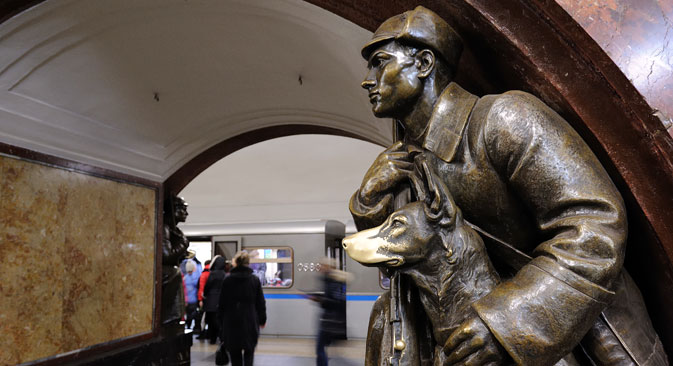Little known facts about Moscow’s iconic Metro

Moscow Metro - facts and urban legends
Lori / Legion-MediaThe Moscow Metropolitan transport system is one of the busiest subways in the world. In 2014, a total of 2.4 billion people travelled on it to go where they needed to go. Over the past 80 years, there have been more than a staggering 145 billion rides on the Russian capital’s metro system.
The Moscow Metropolitan system holds the world record for clocking on-time departures and arrivals. According to the Moscow transport department, the Metro’s accuracy equals an incredibly impressive 99.99 percent. This is particularly impressive considering that the interval between trains during rush hour is only 90 seconds.
The Moscow subway is often called the most beautiful in the world; 44 of the almost 200 stations are listed as cultural heritage sites.
The concept of constructing a subway in Moscow was first conceived as far back as 1875. One such project was actively discussed in 1902, but the city municipal council decreed at the time that the city should “refuse the solicitations” of the architects who had proposed those projects. The construction of a subway system was thus started only in 1931, after the Soviet Union was established. The first 13 stations were opened on May 15, 1935.
The stone from the Serpukhov Kremlin, a Russian architectural monument from the 16th /17th centuries that was dismantled in 1934, was reputedly used to decorate the first Moscow Metro station. The marble used in building the subway reportedly came from the Moscow Cathedral of Christ the Saviour, which was demolished in 1931.
During the Nazi airstrikes of World War II, the Moscow subway, as well as the subways in some other cities, turned into bomb-proof shelters. Around half a million people found shelter in subway stations deep underground. Women and children slept in carriages of trains that were parked overnight next to the platforms.
When German airstrikes were especially frequent, shops and even hairdressing salons opened and were operating at the stations. The Kurskaya metro station had a working library. On the anniversary of the October Revolution, on October 6, 1941, a meeting of the Moscow Soviet was held at the Mayakovskaya station. Joseph Stalin made a speech in which he predicted the inevitable defeat of the fascist bloc.
Even during the Second World War, construction of the subway did not cease: seven new stations were built.
For the first 20 years, the subway system was named after Lazar Kaganovich, a Soviet official responsible for the construction of the Moscow Metropolitan’s first line. In 1955, it was renamed for Vladimir Lenin.
There is an apocryphal story concerning the appearance of the circle line, which had not been planned in the original project. It is said that at a session devoted to the construction of the subway, Stalin put his cup of coffee on the metro map leaving a brown spot around the city centre. Stalin showed the circle to the builders and ordered the construction of such a line. That is supposedly how the circle line appeared and why it is coloured brown on the map.
During repairs of the Kurskaya station in 2008-2009, the original inscription over one of its portals was restored. It includes part of the Soviet anthem from 1944: “Stalin brought us up on loyalty to the people, he inspired us to labour and heroism.” The appearance of this inscription has raised protests from several human rights activists. Some of them have even stated that they will boycott the Kurskaya station.
Several of the stations have been renamed a number of times. The station now known as Alexandrovsky Sad, located not far from the Kremlin, has seen the maximum number of name changes. The station has been called “Comintern,” “Imeni Kominterna,” “ulitsa Kominterna” and, between 1946 and 1990, was known as “Kalininskaya.” For several days in 1990, the station was named “Vozdvizhenka.”
While travelling on the radial lines of the Moscow Metropolitan towards the city centre, the stations are announced in men’s voices and, while going away from the centre, the announcements are made by women. On the circle line men’s voices announce the stations while going in the clockwise direction, with women’s voices used when going counter-clockwise. This is done to simplify orientation for blind people in the subway.
There is one fountain in the Moscow Metropolitan. It is located at the passage between the Rimskaya and Ploshchad Ilyicha stations.
Moscow’s subway features the first station in the world to be situated on a bridge. To this day the station, Vorobyovy Gory, is the only such one of this type in Moscow. It was closed for repairs for 19 years between 1983 and 2002.
Over the past five years underground concerts have been held every May 15, to celebrate the subway’s anniversary. The brilliant acoustics available in the stations make the opportunity too good to pass up. A special mass yoga session was also organised in 2015.
The subway system announced in 2015 that it was getting ready to test an intelligence system to reduce the number suicides and accidents. The media often reports about people who choose the subway as a site to end their lives. The new system’s special sensors are intended to notify train drivers in cases when a person jumps on to the rails.
An ambitious development programme has been put in place recently by the Moscow Metro and, by 2020, the length of the Moscow subway is likely to grow 1.5 times, compared to its length in 2011, with an increase of 160 kilometres of tracks. There are also plans to open 60 new stations for this mass rapid transport system.
All rights reserved by Rossiyskaya Gazeta.
Subscribe
to our newsletter!
Get the week's best stories straight to your inbox
